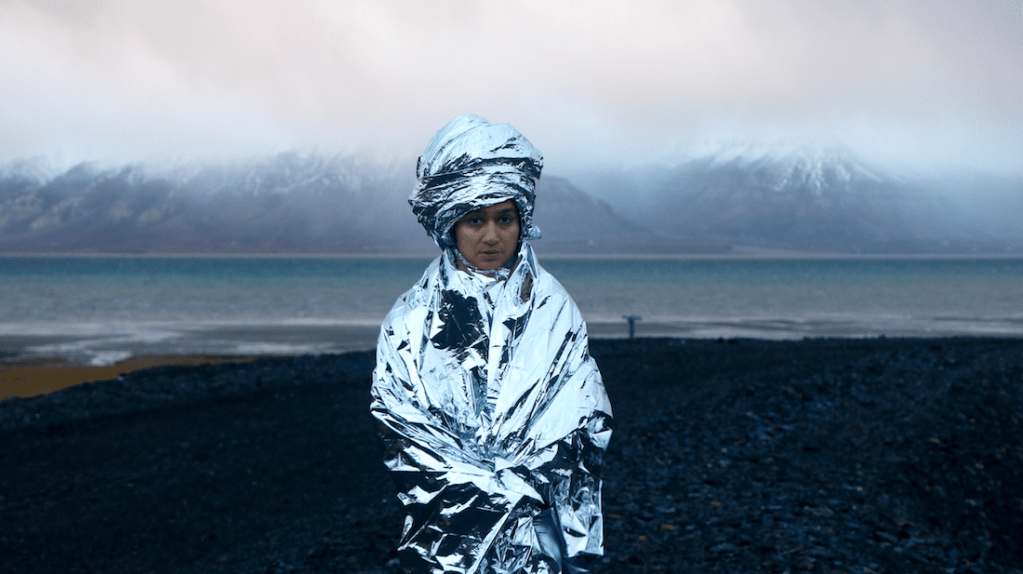Even from the plane, the glaciers looked like cold, wrinkled skin. This image—of white arteries gurgling, of an enormous ice monster—would stay with me during the fortnight I spent as a writer-in-residence on the Antarctic Peninsula, and return to me again when I spent three weeks sailing in the Arctic, through the fjords of Svalbard.
From the barquentine tall ship that doubled as a residence for artists working at the intersection of science, I spent my days in observation, wondering at the mysterious connections between the uninhabited poles and the place I came from, peopled and polluted. I saw geodesic satellite stations, from where the rest of the world monitors its GPS systems, on the tops of plateaus or the bases of mountains. At night, I spotted satellites in the sky: the frequency of their movement is the greatest at the poles. The satellites and the stars looked exactly alike.
Videos by VICE

The Polar Circles. Every year there are dozens of reports of UFO sightings, strange machinery hovering in the sky, the sky pulsing in green, speeding, sounding geomagnetic disturbances. Google Earth captures alien objects that don’t fit in: everything stands out on the blank canvas of ice. UFO hunters and agencies of extraterrestrial investigation look out with hawk eyes, detecting sites of crash landings, curious-looking underwater alien bases and obscure cloud formations that pose seductive anomalies.
This April, NASA scientists captured images of holes in the Canadian Arctic sea ice, with rings of mysterious wave-like patterns. In the past, deep, widening craters, 250 feet and growing, and large, almost perfectly-round stones have appeared in the Siberian Arctic. Peculiar dark, floating “blobs” have been sighted in the Alaskan Arctic. People have spotted a giant staircase to the underworld in Antarctica, the lost pyramid of Atlantis and abandoned spaceships.
Videos such as those by channel Secureteam construe conspiracy from faulty photographs.
For a long time, these lapses of imagination were not simply caused by conspiracy theories but by explorer’s personal accounts, filtered and distorted by mist, deep freeze and distance.
The world revealed itself slowly to the ancient mathematicians and philosophers. In the 6th Century BCE, Pythagoras calculated that the Earth was round; in the 5th, Parmenides postulated five climatic zones; in the 3rd, Aristotle hypothesized that a mythic southern continent must exist. He called it Antarctica, from Greek anti and arktos, meaning “opposite the bear”, the name for the constellation under which the Arctic lay. The poles are prone to speculation, perhaps because they have always been closely connected to the stars.
When Pytheas went on a circumpolar voyage in 350 BC, he discovered Thule, a place beyond the north star on the celestial map of his time. While fanciful medieval maps featured serpents, magical mountains and hybrid creatures, even scientific depictions of the poles, such as Gerard Mercator’s 16th-century map of the Arctic, details an infinite northbound place forming a giant whirlpool with a magnetic black rock at its centre, populated by iceberg leviathans and “polar pygmies”.

Later, Samuel Taylor Coleridge wrote of a giant albatross flying over frozen seas in The Rime of the Ancient Mariner (1834). Jules Verne imagined an ice-free ocean in the Antarctic in his The Sphinx of the Ice Fields (1897). In 1818, Mary Shelley wrote of a man, Victor Frankenstein, wedged in the ice walls of the Arctic. In an essay on “Literature’s Arctic Obsession”, Kathryn Schulz offers that “From antiquity onward, our stories about the poles have themselves been polar: either the ends of the earth are precious, glorious, and ours for the taking or they are desolate, unattainable, and deadly.”
When I first saw the aurora borealis in Ny Ålesund, I screamed. The sky howled green, vibrating like giant organ pipes in a church’s belfry, calling God or something big into being. It sneered at the wind, silencing it. I lay agape on the biting ground below, barely feeling it. I laughed. No amount of explanation could have convinced me that this was not an extraterrestrial arrival. I mean, the sky was conscious.

But that is a natural paranormal phenomenon. A real alien species, Homo Hubris, is in our midst: it’s us.
We are the reason for the increase in UFO sightings. Cameras access previously hidden parts of the world, while the images they capture proliferate across media. The poles are the least explored edges of the Earth, but technology affords us an artificial proximity. Sightings, via Google Earth’s satellite images, NASA/ESA data and the mistakes of social media are testaments to the mistruths construed from faulty photographs.

As polar seas melt, their fragile ecosystems are infected with invasive microbes that are brought over with the current. In truth, holes in the sea-ice are formed by a repeated freeze-and-thaw. The blob is a threatening toxic algae in bright bloom. Since ice is the perfect disguise, science is more uncertain here than anywhere else on earth. It is also what makes the poles hardest to clean up. Pythagoras imagined the Arctic to be a place with polygons floating in space; in reality, ice wedges that undergo a process of repeated melting and freezing form polygon-like structures. Giant cracks aren’t made by supernatural beings with unearthly strength, but the steady, incremental destruction caused by humans themselves.
The fiction around the poles, imaginary or surveilled, is the truth about climate change. In a world obsessed with discovery and light, polar conspiracy theories become symbolic of a vehement ignorance, a refusal of complicity. We know that with bright light comes a lacuna of blindness: our search for other beings is an escape from our own extraterrestrial proclivities. The stark climate catastrophe, accelerating at a pace far greater than the technologies that produced it, will make us literal aliens, in search for a new place to live.
Follow Himali Singh Soin on Instagram.




